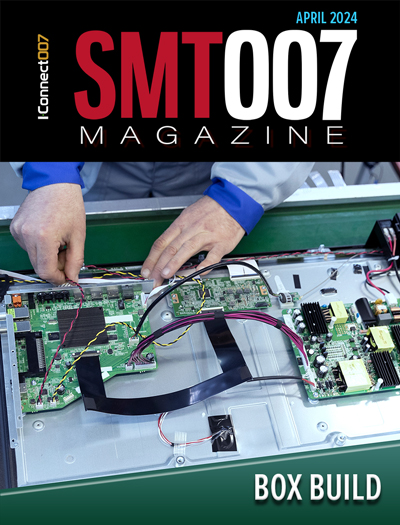-

- News
- Books
Featured Books
- smt007 Magazine
Latest Issues
Current Issue
Box Build
One trend is to add box build and final assembly to your product offering. In this issue, we explore the opportunities and risks of adding system assembly to your service portfolio.

IPC APEX EXPO 2024 Pre-show
This month’s issue devotes its pages to a comprehensive preview of the IPC APEX EXPO 2024 event. Whether your role is technical or business, if you're new-to-the-industry or seasoned veteran, you'll find value throughout this program.

Boost Your Sales
Every part of your business can be evaluated as a process, including your sales funnel. Optimizing your selling process requires a coordinated effort between marketing and sales. In this issue, industry experts in marketing and sales offer their best advice on how to boost your sales efforts.
- Articles
- Columns
Search Console
- Links
- Events
||| MENU - smt007 Magazine
Strategies to Reduce Handling Errors
May 6, 2016 | Stephen Las Marias, I-Connect007Estimated reading time: 1 minute
Despite the advancement in manufacturing technologies, processes in assembly lines continue to involve multiple opportunities for errors or defects to happen. Sometimes, these processes involve factory workers doing repetitive, dull tasks that do not add much value into the overall productivity of the company. More often than not, such causes of errors also involve out-of-date or legacy equipment that electronics manufacturers are hesitant to replace, as doing so entails a significant investment.
Nowadays, the electronics assembly industry is looking more and more into automating their production lines as automation offers several benefits, including a return on investment in the long run; reduced variation; and higher reliability. In our recent survey, the majority of respondents said automation helps them reduce handling errors—or operator errors—in their processes. It also enables faster throughput, as well as reduces the number of processing steps.
However, many companies cannot afford to acquire new and more advanced equipment just to say they are automated. There are many alternative strategies to help assemblers improve their process and reduce errors along the way.
This month's issue of SMT Magazine features other aspects of the assembly line where improvements can be made to increase the efficiency of the process.
Suggested Items
Focus on the New
01/05/2018 | Stephen Las Marias, I-Connect007It seems like it wasn't too long ago when I was writing about the optimism of the electronics manufacturing and assembly industry going into 2017. Now, here we are again at the beginning of the new year, looking at new trends, disruptive technologies, and emerging markets for 2018. I am also proud to announce our new branding as well as our fresh, new look.
May Issue of SMT Magazine Available Now
05/01/2017 | I-Connect007The May 2017 issue of SMT Magazine is available now. This month, our contributors including Indium, MC Assembly, Saline Lectronics, TeligentEMS, Tramonto Circuits, and Blackfox Training Institute discuss the challenge of finding the right talent in the electronics manufacturing industry, and strategies in training them to further the growth of their companies. Learn how they are closely collaborating with educational institutions to make sure there are students who are pursuing careers in manufacturing, and that graduates entering the workforce are capable and qualified for their manufacturing jobs.
April 2017 Issue of SMT Magazine Available Now
04/04/2017 | I-Connect007The soldering process should be perfect. But soldering is just too complex a process, and further complicating the situation, the requirements and technologies vary between our industry’s market segments. The April 2017 issue of SMT Magazine looks into some of the different factors and challenges impacting yield when it comes to soldering, and provides strategies on addressing them.
March 2017 Issue of SMT Magazine Available Now
03/01/2017 | I-Connect007The March 2017 issue of SMT Magazine features strategies and best practices to address the myriad challenges in flex circuit assembly.
December 2016 Issue of SMT Magazine Available Now
12/02/2016 | I-Connect007The December 2016 issue of SMT Magazine examines the myriad challenges facing sales and marketing execs in the PCB assembly industry.


